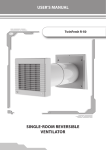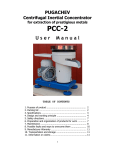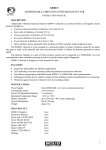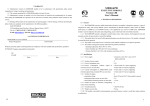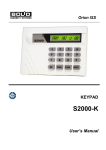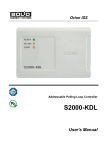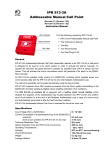Download bolid EFIR-K User`s manual
Transcript
EFIR-K ROLLING CODE UHF REMOTE CONTROL SET (version 2.2) ISO 9001 USER’S MANUAL DESCRIPTION Efir-К Rolling Code UHF Remote Control Set is the strong encryption personal simplex radio system intended to transmit control signals. This device is designed as an alarm and remote control system. Efir-K enables to activate features such as arming, disarming, utility and panic on your security system from the palm of your hand. The Efir-К Remote Control Set consists of: • 2-Button Keyfob, which is a RF transmitter with rolling (or dynamic, or hopping) code capability to provide security, and • Receiver, which is a wireless relay switch controlled by a Keyfob. One transmitter is included into an Efir-K delivery set. A relay switch can be controlled with up to fourteen additional transmitters. Efir-К is useful to: • Work as part of an integrated security systems (for arming/disarming, opening/closing of doors, garage door openers or any movable barriers, or for notification appliances) • Remote relay control of diverse devices • Ensure human safety by means of panic signal transmitting to the Alarm Receiving Center in case of intruder attack • Provide a selected remote access FEATURES: • • Strong encrypted RF transmission Remote control by up to 15 Keyfobs • • • • Lost Keyfob disabling LED indicating of relay actuation and learning mode entering Choosing of suitable operating mode from four available Built-in tamper switch enabling to detect unauthorized lid removing in order to avoid unauthorized Keyfob operations • Relay output with switch-over contacts (up to 3 A) enabling to manipulate remotely by such low voltage devices as visual/audible alarms, video cameras, locks, garage door openers, and motors SPECIFICATIONS RF Carrier Frequency 433,92 MHz Signal Encoding Technique dynamic code Receiver Working Range up to 60 m Number of Operating Modes 4 Keyfob RF Power Output 5,0 mW maximum Maximum Number of Keyfobs 15 Receiver Power Requirements 10 ÷ 14,5 Vdc Consuming Current (in case of 12 V voltage): o for Non-Operating Relay 6 mA o for Operating Relay 15 mA 1 Output NO/COM/NC Contacts Operating Temperature Ranges: o Keyfob o Receiver 2А@120 Vac, 3A@24 Vdc −10 C to +40 C −30 C to +40 C WHAT’S INCLUDED Receiver (without power supply) 1 pcs RF Keyfob with built-in accumulator 1 pcs User’s Manual 1 pcs Package 1 pcs Screw 2 pcs Dovel 2 pcs Additional Keyfobs (up to 14) can be supplied in separate order. OPERATING DIRECTIVES The Receiver PC board layout and 2-Button Keyfob view are demonstrated in Figure 1. Плата приемника Receiver PCB Радиобрелок 2-Button Keyfob Relay LEARN button Large Button1 кнопка Receiver LED Jumper J Small Button кнопка 2 Tamper switch SC 12V+ 1 2 Tamper NO COM 3 1 4 2 NC 12V- 3 4 Light Indicator индикатор Terminals are: −12 V +12 V Tamper NO COM NC SC - Power supply negative pole input - Power supply positive pole input - Built-in tamper switch contacts - Normally opened dry relay contact - Common dry relay contact - Normally closed dry relay contact - reserved for use in future Figure 1: Efir-K Remote Control Set RECEIVER MOUNTING Receiver overall and mounting dimensions in mm are represented in Figure 2. Caution: The Receiver operating range is strongly dependent on its location, as well as on relative receiver-transmitter position. Large building constructions and metal objects, power lines, vehicles as well as humans can disturb RF propagation. Landscape details and surrounding vegetation can also attenuate the signal. In order to improve range of performance attach the Receiver upright away from strong thermal sources, air conditioners, direct sunlight, places likely to cause water drops within the Receiver. Technogenic/human factors should be minimized; particularly the RF sources other than signal from Receiver. Avoid locations with constant strong electromagnetic fields. Do not let the Receiver to touch metal objects or to be situated behind metal blinds. Do not install the receiver close to concrete-steel constructions (less than 0,5 m apart). In case of fixing to a concrete-steel wall use nonmetallic brackets or some other means so that there will be a distance between a Receiver and a wall no less than 10 cm. 2 14 14 56 84 56 4 holes 3х8 84 Figure 2: Overall and Mounting Dimensions The line of sight between a Receiver and a Keyfob should be free of obstacles. Inspect the Receiver being placed at selected point detects the signals from all possible user locations. In order to eliminate deadzones or to increase the operating range it can be possible to locate several Receivers at various locations, the same Keyfobs being to be registered by each of them. In such a case Receiver relay outputs can be connected either to the same or to diverse executive devices. A Receiver mounting procedure is as follows. 1. Select the suitable location keeping in mind all recommendations mentioned above. 2. Take off the Receiver lid. 3. Firmly fix the Receiver base with supplied screws and dowels. 4. Wire the corresponding Receiver terminals to a power supply and an executive device in agreement with required electrical scheme. Some typical application examples are specified below. 5. If necessary connect the Receiver tamper terminals to an available tamper alarm zone. The Receiver tamper is brought into a scheme along with EOL resistor in series. The value of EOL resistor is strongly dependent on specified connecting scheme and the equipment the tamper to be connected to, so, this subject is beyond the scope of this manual. 6. Replace the Receiver lid. 7. Power up the Receiver and the executive device. RECEIVER OPERATING MODES A short pressing on the large Keyfob button activates the relay, while a short pressing on the small one close the relay operation. The Keyfob light indicator lights up when a button is pressed (that is, the relay is activated). The relay can operate by four different ways (or modes) depending on the executive device required behavior. The minimal relay actuating time shall not be less than 2 seconds irrespective of operating mode. Mode #1: The relay is actuated by a large button pressing and remains on until the small Keyfob button has not been pressed. Mode #2: The relay is actuated by pressing on both large and small Keyfob buttons and remains on until they have been released. Mode #3: The relay is actuated by pressing on large Keyfob button and remains on until it has been released. Mode #4: The relay is actuated by a large button long pressing (more than 3 seconds) and remains on until the small Keyfob button has not been pressed. 3 RECEIVER OPERATING MODE PROGRAMMING 1. Power off the Receiver and remove the Receiver lid. 2. 3. 4. 5. Put on the jumper J. Connect a 12 Vdc power supply to the Receiver. Power on the Receiver. Consider the Receiver periodically blinking. The number of flashes in sets (singly, by twos, in trees or in fours) denotes the current operating mode number. 6. To increase the operating mode number press the large Keyfob button. Inversely, to decrement the operating mode number press the small Keyfob button. 7. Power off the Receiver. 8. Take off the jumper J in order to save the changes. ADDITIONAL KEYFOB PROGRAMMING 1. Take off the Receiver lid. 2. Connect the Receiver to a 12 ± 2 V direct power supply. Power on the Receiver. 3. Ensure there are no other operating RF transmitters closer than 50 meters. 4. Shortly (within no more than 2 seconds) press the LEARN button located on the Receiver PC board to program a new Keyfob. The Receiver LED shall light up indicating programming mode initiating. DCaution: Holding the LEARN button for more than 8 seconds will erase the Receiver memory so that data about all Keyfobs programmed before will be lost. 5. Shortly press large or small Keyfob button and ensure the Receiver LED goes off. If the LED has no gone off then the RF relationship between Receiver and Keyfob is not created. DCaution: If the programming Keyfob button is not pressed within 30 second interval, having been expired since Receiver programming mode initiating (pressing of the PC board LEARN button), the programming mode will be prohibited. To resume the programming procedure return to the step 4. 6. In case of programming having been successful (the Receiver LED has gone off after pressing a Keyfob button) press the Keyfob button once more. 7. To program another Keyfob (no more than 14 additional ones can be programmed) repeat the steps from 4 to 6. 8. Bring the lid back onto the Receiver base. 9. Ensure all programmed Keyfobs are capable to operate properly having been located at the ordinary places. RECEIVER MEMORY CLEARING Remove the Receiver lid and keep LEARN button pushed for more than 8 seconds. All Keyfobs data having been already registered will be deleted. 4 TYPICAL APPLICATION How to Use the Efir-K as a Panic Alarm System 1. Make your election of a required Receiver operating mode and program it as explained above. 2. Program the needful number of Keyfobs to be in use. 3. Attach the Receiver at a suitable location where all programmed Keyfobs are operating. Do not place the Receiver behind metal blinds, near large metal objects, power lines, air conditioners and sources of the electromagnetic, thermal and RF fields. 4. Include the Receiver into available security system connecting switch-over relay dry contacts to the Security Station communication line. The Receiver wiring diagram for such an application is shown in Figure 3. 5. Connect the Receiver to a usable power supply. Such a system operates as follows. As needing help any security system owner sends out an encoding panic signal by means of corresponding Keyfob button pressing. The Receiver detects the signal and decrypts it. If the signal is authentic Receiver opens the relay dry contacts connected to the communication line. As a result Security Station alarm is activated signaling alarm conditions having occurred. Receiver Keyfob 1 Keyfob 2 ………… Signal is transmitted to a Security Station Keyfob 15 Figure 3: Using the Efir-K for Panic Signal Transmitting 5 How to Use the Efir-K for Arming/Disarming The Efir-K Set can be used as a part of burglary alarm system for remote arming and disarming of protected premises being co-operated with any control and indicating equipment. Let us consider the Efir-K Set integrating into the security system based on BOLID Company manufactured control and indicating equipment such as SIGNAL-VKA, SIGNAL-VK2, SIGNAL-VK-4P, SIGNAL-VK4 iss.05 and SIGNAL-VK6. To use the Efir-K in such a manner: 1. Program the Receiver to be of operating mode #1 as explained before. 2. Program the needful number of Keyfobs to be in use. 3. Attach the Receiver at a suitable location where all programmed Keyfobs are operating. Do not place the Receiver behind metal blinds, near large metal objects, power lines, air conditioners and sources of the electromagnetic, thermal and RF fields. 4. Wire the Receiver to your SIGNAL equipment according with the scheme in Figure 4 and directions from Table 1. Such a system operates as follows. Being coming out of premises an owner closes the door and presses on the large Keyfob button. An encoded control signal is sent out at once. The signal is detected and decoded by Receiver. In case of authorization having been successful, the Receiver relay is switched on forcing the SIGNAL device for arming. The Receiver LED shall light by red. In order to go inside the premises an owner presses on the small Keyfob button. If the owner stands within Receiver reach then the Receiver returns the relay to its initial state and the LED goes down. The SIGNAL device stops monitoring for protecting zones enabling entering inside object without any alarm. Connecting of an Efir-K Receiver to a SIGNAL control and indicating equipment is specified in Table 1. Receiver Keyfob 1 SIGNAL Keyfob 2 ………… Keyfob 15 12 VDC OUT to NC to COM Figure 4: Using the Efir-K for Arming and Disarming 6 Burglary Zone Table 1: Connecting Efir-K Receiver to a SIGNAL Control and Indicating Equipment Control and Indicating Equipment Terminal Model Name Contact Block SIGNAL-VKA SIGNAL-VK2 Efir-K Receiver Terminal Contact Block +12V 8 2 СОМ (common) armed/ disarmed 11 3 NС (closed) 0V 7 4 -12V +12V 8 2 +12V Solder to the contacts 1 and 2 of S3 switch 1 NO (opened) ХТ2 ХТ2 ХТ2 -12V 12 2 СОМ (common) ХТ2.3 +12V 11 2 +12V ХТ1 ХТ2 -12V 12 4 -12V ХТ2 Armed/ disarmed 11 2 СОМ (common) Armed/ disarmed 12 3 NС (closed) +12V 11 2 +12V XT1 -12V 12 4 -12V ХТ2 Crypto Device - 1 NO (opened) SIGNAL-VK-4P ARMED/DISARMED button of SIGNAL-VKA has to be set to ARMED position, that is has to be pushed ХТ1 ХТ2.3 ХТ3 Remarks ХТ2 ХТ2 ХТ5 SIGNAL-VK4 iss. 05 ХТ2 ХТ21 SIGNAL-VK6 ХТ10 ХТ2 Crypto Device - 2 СОМ (common) +12V 9 2 +12V XT1 -12V 10 4 -12V ХТ2 Armed/ disarmed 1 3 NС (closed) Armed/ disarmed 2 2 СОМ (common) +12V 1 2 +12V ХТ1 -12V 2 4 -12V ХТ2 ХТ2 7 How to Use the Efir-K for Electromechanical Device Manipulation 1. Program the Receiver to be of operating mode #3 as explained before. 2. Program the needful number of Keyfobs to be in use. 3. Attach the Receiver at a suitable location where all programmed Keyfobs are operating. Keep in mind all mounting recommendations given on page 3. 4. Wire the Receiver in accordance with the connecting diagram presented in Figure 5. Let’s consider the specific example of such a system operating for an electromagnetic lock. In case of sound or visual alarm, motor or video camera manipulations the process is similar. Initially an entrance door is closed, and the lock is switched on. When an owner is about going away, he presses and holds the large Keyfob button sending out an encrypted executive signal. The Receiver detects the signal and decodes it. If the signal is authorized the switch-over dry contacts are opened following by the lock opening. In such a process the Receiver LED shall light by red. After having gone from the object the owner closes the door and releases the large Key button. The Receiver LED shall go out. The lock switches on blocking the door. Coming back the owner repeats actions described before. If he stands within coverage area the Receiver opens the door, the Receiver LED lighting by red. After having entered the owner releases the large button, after which the lock is closed and the LED goes out. Dwelling within the building an owner in such a manner can provide a selective access control or garage door opener (or any movable barrier) manipulating. 12 Vdc UPS Receiver Keyfob 1 − + Keyfob 2 COM NC ………… End switch To the electromagnetic lock Keyfob 15 Figure 5: Using the Efir-K for Low Voltage Device Remote Control 8 WARRANTY Manufacturer warrants its Efir-K Remote Control Set to be in conformance with specification under normal transportation, storage, mounting and maintenance. The Efir-K Set average operating life is at least 10 years. Manufacturer warrants its product to be free from defects in materials and workmanship for 12 months since putting the Efir-K into operation, but no more then 18 months since production under normal use and service. Sending off the Efir-K to the manufacturer for repairing accompany those with a damage certificate describing the defect. Send your complaints to the manufacturer at the following address: ZAO NVP BOLID #4, Pionerskaya street, Korolyov, Moscow Region, Russia, 141070 Tel./fax +7 495 777-40-20, +7 495 516-93-72. E-mail: [email protected], Web-site: http://www.bolid.ru. 9 ACCEPTANCE CERTIFICATE Efir-K Rolling Code UHF Remote Control Set Product Designation Serial Number Produced, tested by quality control department in compliance with state standards and specifications, packed by NVP BOLID Company and qualified as deliverable. Q.C. STAMP 10 _____________________ Name ____________________________ Date











